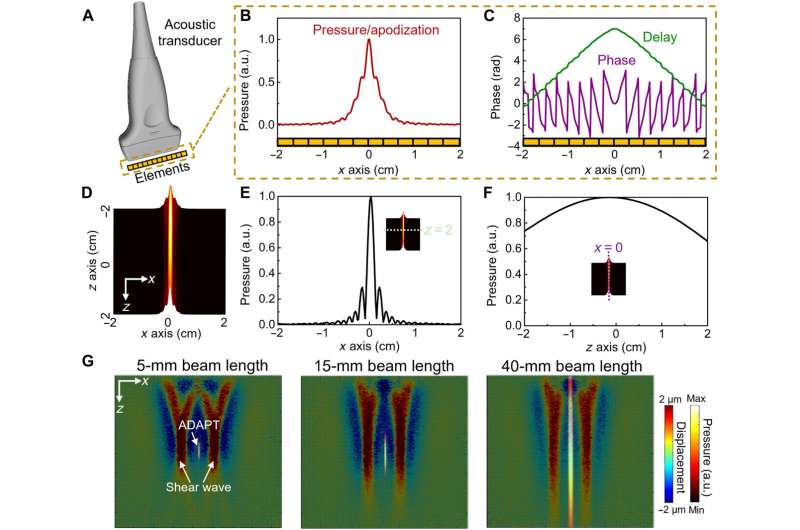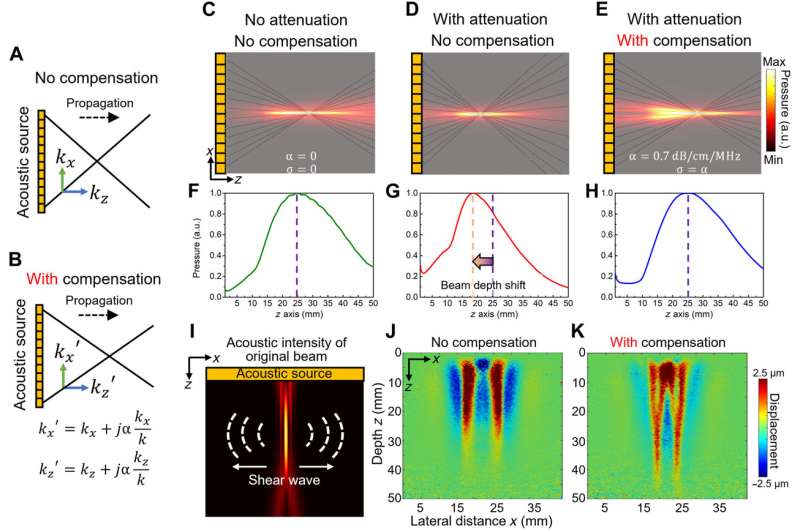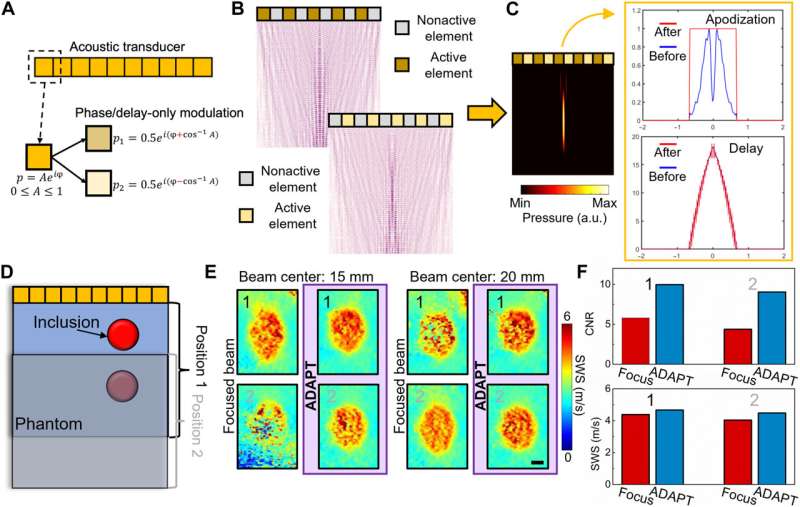November 21, 2023 feature
This article has been reviewed according to Science X's editorial process and policies. Editors have highlighted the following attributes while ensuring the content's credibility:
fact-checked
peer-reviewed publication
trusted source
proofread
Acoustic diffraction-resistant adaptive profile technology for elasticity imaging

Acoustic beam shaping with high degrees of freedom is critical for ultrasound imaging, acoustic regulation, and stimulation. The ability to fully regulate the acoustic pressure profile relative to its propagation path remains to be achieved.
In a new report published in Science Advances, Yuyang Gu, and a team of scientists in radiology at the Massachusetts General Hospital, U.S., describe an acoustic diffraction-resistant adaptive profile technology to generate a propagation invariant beam with a desired profile.
To accomplish this, they leveraged the wave number and beam multiplexing to develop a general framework and create a highly flexible beam with a linear array ultrasound transducer. The designed acoustic beam maintained a beam profile in the material by compensating attenuation.
The scientists showed shear wave elasticity imaging as an important modality to benefit from the method to evaluate tissue mechanical properties. Together, the technology overcame existing limits of acoustic beam shaping suited for a variety of applications including medicine, biology, and materials science.
Acoustic beams
The interest in shaping a desired acoustic beam has broad applications across biomedical imaging, sensing, and particle manipulation. Such acoustic beam methods are inspired by the fundamental physics governing wave propagation to benefit multidisciplinary fields including biology, and biomedical engineering.
Researchers have hitherto considered a class of acoustic beams known as propagation-invariant or nondiffracting beams. The classic propagation-invariant beams include the Bessel beam, airy beam, Mathieu, and Weber beam; each with unique features for wide-ranging applications in optical research.
Examples include optical tweezers, ultra-resolution imaging, and nanoscale material processing. The acoustic beam Bessel is suited for telecommunication, and acoustic tweezers, where the acoustic airy beam can efficiently bypass any obstacle in the wave propagation path.
Generating the acoustic diffraction–resistant adaptive profile technology (ADAPT)
In this work, Gu and colleagues described a generalized framework to generate propagation-invariant acoustic beams known as acoustic diffraction-resistant adaptive profile technology (ADAPT) to realize arbitrary longitudinal pressure distributions. The scientists first introduced the basic concept with superimposed Bessel beams to realize beam shaping with a linear array transducer.
While the conventional focused beam only provided a limited effective imaging area at the beam focal depth, the method produced a beam with a user-defined region of interest to obtain an extended imaging area with higher accuracy.

Shaping propagation-invariant acoustic beams
There are two well-established methods to shape an acoustic beam. One method aims to classically shape focused beams by combining a predefined single focal position and the information of the acoustic source. The other method aims to directly map the known pressure or phase distribution function including the Bessel function to each pixel in the acoustic source. Both methods are suited to regulate the longitudinal acoustic profile of the beam.
The ADAPT method (acoustic diffraction-resistant adaptive profile technology) introduced in this work combined both methods by separating a predefined acoustic beam into multiple Bessel beams with different wave numbers and coefficients. The schematic of the ADAPT-based beam with an example predefined pressure profile includes a random, three-section high-pressure region defined as an 'isolated' and propagation-invariant pattern.
A set of Bessel beams formed the final beam, therefore the non-diffractive beam markedly decreased pressure outside the desired high-pressure region via wave-interference. By separating the beam into multiple weighted Bessel beams, Gu and team interpolated the amplitude and phase distribution of each pixel or element to coherently sum up the final amplitude and phase applied to the acoustic transducer.
The team showed how the ADAPT-based beam profiles can be stretched flexibly, compressed, or divided, to generate acoustic beams at different axial locations.

Beam multiplexing
The team found that simultaneously generating the requisite Bessel beams by using a single multielement acoustic wave was challenging. Unlike propagation-invariant laser beams that are generated by using a combination of multiple lenses and photomasks, the acoustic propagation invariant wave maintained a narrower spatial frequency bandwidth that corresponded to limited spatial modulation capabilities. As a result, Gu and team used a multiplexing method to generate the ADAPT-based beam with the desired features.
In its mechanism-of-action, the scientists aligned the beam with the highest transverse spatial frequency requirement to the array element size by using the total spectral bandwidth of the transducer to simultaneously produce multiple acoustic beams with different wave numbers.
The variables of frequency, pitch and element size affected the transverse and axial wave numbers to influence the spatial bandwidth of the acoustic beam. While higher frequencies yielded narrower beams with increased resolution and limited penetration depth, lower frequencies resulted in wider beams with increased penetration but lower resolution. Gu and colleagues adjusted the pitch and element size to regulate spatial resolution, to enable a wider range of beam generating possibilities.
Adaptive shear wave generation via ADAPT
When an acoustic wave is propagating inside a material, this will generate an acoustic radiation force. Such radiation forces are proportional to the rate of change of momentum of an acoustic wave propagating in a medium.
Gu and team showed how the impulsive excitation of an acoustic beam can induce the transient laterally propagating shear wave with a shape that depends on the geometry of the beam. This shear wave speed is directly proportional to the elastic properties of the medium, allowing the researchers to conduct experiments inside a tissue-mimicking phantom with the Verasonics research scanner. The team regulated the specific input parameters, including beam center location and length to achieve the desired line-shape profile.

Outlook
In this way, Yuyang Gu and colleagues describe a method known as acoustic diffraction–resistant adaptive profile technology (ADAPT), to generate propagation-invariant acoustic beams. Such beams can be generated with a single, linear-array transducer using Bessel beam multiplexing.
This method offered a high degree of freedom to regulate the longitudinal acoustic energy, and optimize the method across a variety of applications. The non-diffracting nature of the ADAPT-based beams allowed acoustic attenuation and diffraction in the material for the acoustic beam to maintain the desired profile effectively during propagation.
Gu and colleagues suggest the introduction of a variety of add-on features, to increase its applications, including shear wave elasticity suited for medical imaging, sonar, and acoustic tweezers.
More information: Yuyang Gu et al, Acoustic diffraction–resistant adaptive profile technology (ADAPT) for elasticity imaging, Science Advances (2023). DOI: 10.1126/sciadv.adi6129
Journal information: Science Advances
© 2023 Science X Network



















